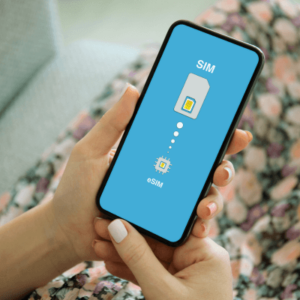This guide is crafted for the tech enthusiast eager to explore the ins and outs of eSIM technology for tech enthusiasts—a leap towards a future where connectivity is invisible, integrated, and incredibly user-centric.
What is an eSIM?
An eSIM (Embedded Subscriber Identity Module) revolutionizes the traditional SIM card concept by embedding a programmable SIM directly into devices. Unlike its physical counterparts, an eSIM can be reprogrammed to support different carriers or plans without needing to swap out a physical card. This tiny yet powerful component is poised to change how we connect to cellular networks, offering a level of flexibility previously unimaginable.

The History of eSIM Technology
The concept of eSIM technology began taking shape in the early 2010s, against a backdrop of rapidly advancing smartphone technology and the burgeoning Internet of Things (IoT). The need for a more adaptable, efficient means of maintaining cellular connectivity across various devices was clear. In 2016, the GSMA (Global System for Mobile Communications) standardized the eSIM, setting the stage for its integration into consumer devices. Since then, eSIM has been adopted by leading manufacturers and carriers worldwide, marking a new era in telecommunications.
Connecting to eSIM Technology for Tech Enthusiasts
Transitioning to eSIM technology is straightforward, and designed with the user experience in mind:
- Device Compatibility: Ensure your smartphone, tablet, or wearable supports eSIM technology.
- Choosing a Plan: Select a cellular plan from a carrier that offers eSIM services. Many providers now offer competitive eSIM-only plans.
- Activation: Once you’ve chosen a plan, activation usually involves scanning a QR code provided by the carrier or downloading a carrier’s app and following the instructions. The eSIM is then activated remotely, connecting you to the network without physical intervention.
Benefits of eSIM Technology for Tech Enthusiasts
- Unmatched Flexibility: Swap carriers or plans without swapping SIM cards—ideal for those who travel or want to easily manage multiple numbers.
- Simplified Device Design: Without the need for a physical SIM slot, devices can be made slimmer and with more room for other features.
- Ease of Use: Managing your plan through software means no more lost SIM cards or paper clips to change them.
- Enhanced Security Features of eSIM Technology: eSIMs reduce the risk of SIM cloning and other forms of SIM-based fraud.
A Guide to eSIM Technology for Tech Enthusiasts
For tech enthusiasts looking to make the switch, the key is compatibility—both with your device and chosen carrier. Research is vital; check your device’s specifications and carrier support for eSIM technology. Consider your needs—are you a frequent traveler, or do you require multiple lines for personal and business use? eSIM offers solutions that traditional SIM cards cannot match.
Activation processes vary by carrier but typically involve a few simple steps through the carrier’s app or website. Once set up, managing your eSIM settings is done directly from your device, offering unparalleled convenience and control over your connectivity.
The transition to eSIM technology represents not just a shift in how we access cellular networks but a broader move towards a more connected, streamlined digital world. For tech enthusiasts eager to lead the charge into this new era, understanding the nuances of eSIM and how to leverage its benefits is crucial. Here’s a detailed guide to help you navigate this terrain.

Understanding Device Compatibility
Step 1: Check Your Device
Not all devices are created equal when it comes to eSIM technology. The first step is to ensure your device—be it a smartphone, tablet, or wearable—is eSIM compatible. Most modern devices from major manufacturers now support eSIM, but it’s essential to verify this before proceeding. This information is usually available in the device’s settings under “Cellular” or “Mobile Data” options or by consulting the manufacturer’s website.
Selecting a Carrier and Plan
Step 2: Choose Wisely
With the device compatibility box checked, the next step is selecting a carrier that supports eSIM and offers plans that meet your needs. This might be your current provider or a new one if you’re seeking better coverage or pricing. Many carriers worldwide have embraced eSIM, offering a range of plans designed to cater to various user needs, from extensive international roaming packages to budget-friendly local data plans.
Research Is Key
Invest some time in researching the best eSIM plans available, considering factors like data allowances, call and text inclusions, international roaming rates, and monthly costs. Remember, one of eSIM’s significant advantages is the ease of switching providers, so you’re not locked into a poor choice for long.
Activating Your eSIM
Step 3: Activation Made Simple
Once you’ve selected a plan, activation is typically straightforward. Most carriers will provide a QR code, which you can scan with your device to initiate the setup. Alternatively, some may require you to download their app or enter details manually into your device’s settings.
Managing Your eSIM
Step 4: Control At Your Fingertips
With your eSIM activated, managing your plan becomes a breeze. You can often switch between multiple eSIM profiles if you have several lines (e.g., one for personal use and another for business), or if you’re comparing plans from different carriers. This control is especially handy for international travelers, who can preload eSIM profiles for their destination countries before leaving home.
Troubleshooting and Tips
Even with technology as advanced as eSIM, you might encounter hiccups. Common issues include activation errors or connectivity problems after switching profiles. Here are a few tips for troubleshooting eSIM issues:
- Restart Your Device: Sometimes, the simplest solution is the most effective. A restart can often resolve connectivity issues.
- Check Carrier Compatibility: Ensure the eSIM profile you’re trying to activate is supported by your device and within a covered network area.
- Consult Carrier Support: If problems persist, reach out to your carrier’s support team. They can offer guidance specific to your situation and help troubleshoot any issues.
Conclusion
For the tech enthusiast, eSIM opens up a world of possibilities, making our devices smarter, sleeker, and more connected than ever before. By following this guide, you can smoothly transition to eSIM technology, ensuring you’re at the forefront of digital connectivity. Whether it’s the ease of managing multiple profiles or the freedom to choose the best carrier for your needs, eSIM technology is a significant step toward a more integrated and flexible mobile experience.
Testimonials from Users
- “Seamless Global Travel: I switched to eSIM for my international business trips, and it’s been a game-changer. No more juggling SIM cards or exorbitant roaming fees.” – Clara M., International Consultant
- “Ultimate Convenience: Managing my eSIM is a breeze. It’s one less thing to worry about when I’m upgrading my phone or changing plans.” – Raj P., Tech Blogger
- “Future Ready: eSIM represents the future of connectivity. My devices are sleeker, and I feel ahead of the curve every time I effortlessly switch plans.” – Sofia T., Gadget Enthusiast
Elevate your connectivity experience with the power of eSIM. Discover the ideal eSIM plan for your lifestyle and join the forefront of the digital revolution. Don’t just connect; connect smarter.



